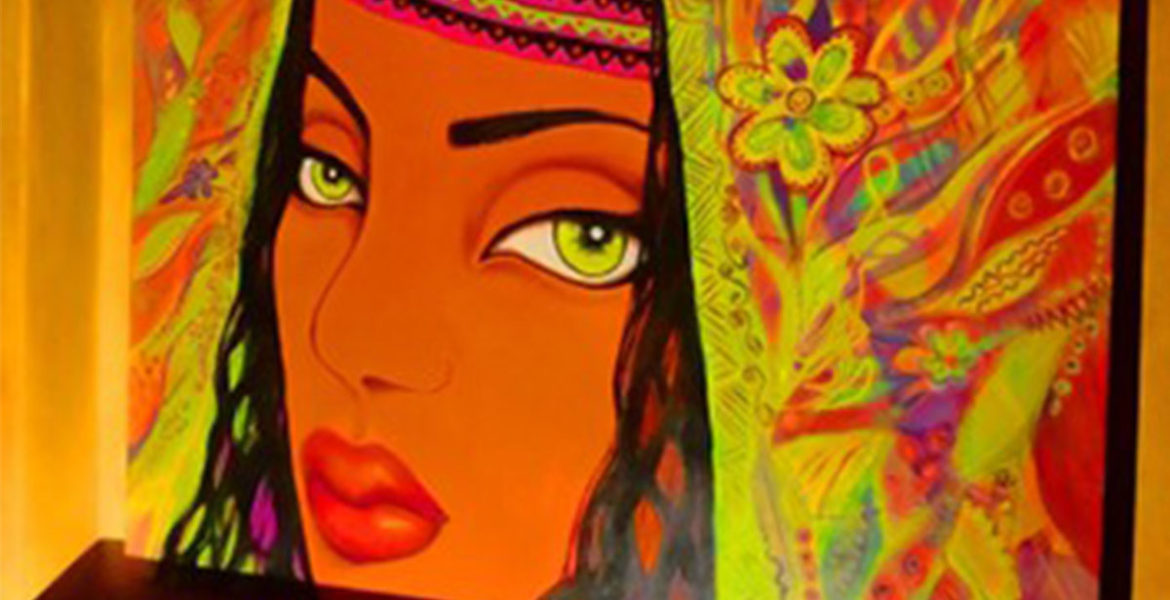With striking bold colors, broad lines and impeccable female portraits employed in each painting of hers, Hanan Ghanem’s paintings have taken Egypt by storm. Her work is unique, honest and has been portraying women as they should be portrayed. No wonder it was used in the hit Ramadan series Asia. After all, her heroines are strong, beautiful and proud, “after the revolution, I felt so much love for women on the streets and in protests. I wanted to say to them ‘I like you, you’re strong, beautiful, deep and much tougher than anyone else. Keep going.’” We sat down with her and discussed this all a little further.
Your style and use of colors are very unique. Is this how you chose to paint from the beginning or did it develop with time?
That was the main idea from the beginning, to create something that’s very simple but expresses me as a woman. I want to take women and make the entire production revolve around them. I would think about each one of them and imagine what her life must be like, figure out what her story is.
How was your style received when you first started out?
It was difficult at first because it was new and unconventional. However, when they saw that it was working well and continuing in the same direction they realized it was my own style. It took a lot of effort and I drew many classics and researched a lot until I got to a style that anyone will recognize as mine.
Your work with Asia was extremely interesting. Do you expect art to be incorporated more often in mainstream media now that it has happened with you?
I really hope so. It was great to see art become part of the on-set décor. Before that, even if a character was a painter, they would just have any painting that he would scribble over.
What was it like, having your work shared on such a wide scale?
It made me very happy. I had people calling me and telling me that my work was on TV. The fact that they recognized it is great. It’s what any artist wants, for their art to reach people.
Have you ever faced sexism in the art business?
No, I don’t think so. We have many female artists and some of them are even veiled now and it’s totally accepted.
Women in Egypt face many injustices purely based on their gender, how can art help them as a creative outlet?
I witnessed this first-hand with my work. I had many women contacting me, telling me that I expressed them so well. They felt the message in my work. They told me they felt that I drew them beautiful and proud. Even if one of my portraits is of a sad woman you will still see pride in her eyes.
Did the sudden burst of awareness due to social media and the Arab Spring help make Egyptians more susceptible to accept and taste art?
Yes, in the beginning they paid attention to my paintings online, but now they’re actually going to galleries. Now that things are more stable, people are starting to look for things that they enjoy.
Has social media helped you spread word about your art?
When I first started online I didn’t care about selling, I just wanted to deliver a message. It was also a way to start over for me because at that point I hadn’t painted for 12 years. I created a Facebook page and with time I got a decent number of fans. I also have a website now but it’s unfinished. My blog is always updated, though.
Many artists nowadays rely on social media almost exclusively when it comes to promoting their art, what do you think of that?
It makes things a lot easier. In Egypt, when Arts Mart started out, it was really nice because you got to see art. When they first started out I gave them 5-6 paintings and they were all sold. This means that people will look for art online and it’s important, especially in Egypt.
Do you think it’s important for an artist to study art first or is it all about talent?
It depends, if someone is extremely talented and they studied on their own, it might not be necessary for them to go to art school. We, Fine Arts graduates, know that what helped us the most is researching in the library. If you are studying art, the most important part is to feed your mind and go to galleries. The more you see the more you create your own ideas.
Are Egyptians now more accepting to paying for art or is it still considered a luxury?
They are! I am always surprised by the fact that they will pay a lot for art. When I first started out I thought to myself, “this is right after the revolution, people may not be able to afford art”, and I kept putting up the cheaper paintings but I realized that the expensive ones are being sold too. That being said, very expensive paintings are usually bought by people who like to show them off. Whenever you go to a gallery you see the same people, other artists and the elite collectors who go there to see if they can invest in a painting. People who have that kind of money are usually older. I paint for people like us, those who want to put a beautiful painting in their home.
Hanan’s Blog: hanan-g.tumblr.com
Facebook: Hanan Ghanem

